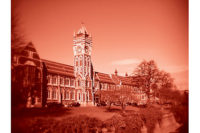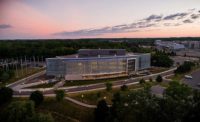Often, hands-on experience is the best way to prepare college students for life in the real world. That’s the goal of the Omron Senior Design and Robotics Laboratory at the University of Houston.
Through its charitable arm, Omron Corp. recently donated money to the Cullen College of Engineering to renovate existing lab space. It also supplied cutting-edge factory automation equipment and technology, such as motion control systems and sensors. The 1,600-square-foot lab is comprised of two rooms that are painted a shade of Omron blue.
“Omron also donated three training units that enable students to learn how to use programmable logic control (PLC) devices for factory automation applications,” says Len Trombetta, associate chairman of the electrical and computer engineering department. “That’s a very marketable skill that has benefitted our students when they graduate.
“Learning about PLCs has enabled young engineers to discover more about how automated factories work,” adds Trombetta. “They’re also developing all kinds of ideas for new industrial automation projects.
“Having a dedicated state-of-the-art laboratory space makes a huge difference to the students,” claims Trombetta. “If you walk into a laboratory, and there’s equipment there for you and
resources available to you, you’re going to do a better job than if you have to fight for a bench or scrounge for equipment.
“It means a lot for the students to be able to come in and have a place they call their own, where they can work on their projects and have all the equipment and resources they need,” Trombetta points out.
The lab contains an area dedicated to senior design projects that provide real-world experience that is helpful for finding jobs after graduation. The capstone program is a three-credit course that undergrad engineering students take during their last two semesters in school.
“Senior design projects are one of the last major hurdles engineering undergraduates tackle before graduation,” explains Trombetta. “They take other courses as well at the same time.
“But, prospective employers will expect students to speak intelligently about what they worked on for their design project, so the experience they gain at this stage is very important,” says Trombetta. “This [lab] makes our graduates very marketable because these are skills companies want.”
Recent senior capstone projects have covered a wide range of topics. Some students have been sponsored by local companies such as BP, Shell and National Oilwell Varco. But, many projects have not been directly related to the oil and gas industry.
For instance, one team of students built a small robotic arm using a 3D printer. It can pick up resistors, determine their value and place them into a bin. Another robotic arm was designed to respond to voice commands and pick up tools. The benchtop device can identify specific wrenches and present them to a human.
There have also been several drone experiments. One prototype can pick up and deliver small objects weighing less than 5 pounds. In addition, some software projects have programmed drones to autonomously fly inside buildings on campus.
The Omron Foundation has been supporting University of Houston students since 2010, when it established the Omron Scholarship in electrical engineering. Omron also provides one-on-one mentoring to students and sponsors some senior design projects.
“We want to bring the skills they have learned in school into the manufacturing sector,” says Robb Black, president and CEO of Omron Automation Americas. “I think it’s a great way for students to learn real-world technology and apply it once they leave.”
The Omron Foundation is funded by the company’s U.S. subsidiaries, which contribute a portion of sales revenue to the organization. The foundation divides its charitable resources among organizations that benefit education, people with disabilities, cultural programs, health care and other social concerns, such as disaster relief.




